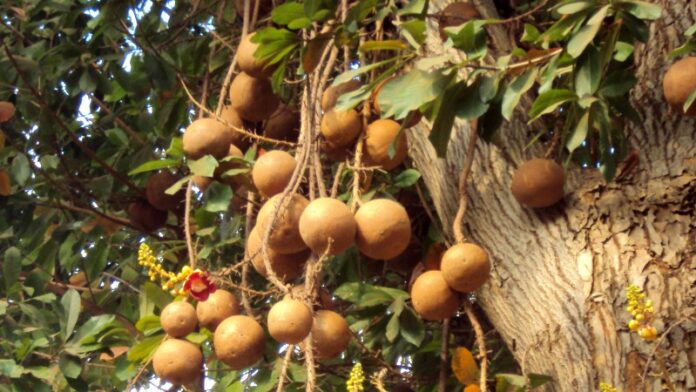You don’t expect to find trees with bizarre labels such as the “pong-pong”, sausage or cannonball tree, but all these species, alive and well here in Phuket, are so named on account of their strange fruit.
Of these odd-balls, the one you are most likely to encounter is the “pong-pong”, or cerbera odollam. A hardy native of Malaysia, this member of the apocynaceae genus grows to a height of about 10 metres, and is frequently cultivated in tropical gardens on account of its glossy leaves and continuous display of fragrant clusters of white flowers with yellow centers which open at branch tips.
I know several resorts on the island where the “pong-pong” has been planted at the edges of car parks or other open spaces. There are several, probably self-sown, decorating the road from Chalong Circle as it begins its serpentine progress upwards towards Kata.
But its real appeal for many gardeners lies in its large globose fruit ‒ glossy, green spheres that look most attractive on the tree. If you are contemplating a shady presence, this is definitely one to consider, since the dense crown has layered, evergreen foliage. Moreover, it can be propagated from seed or cuttings and begins flowering after a couple of years. Just remember that in common with most members of the family, both fruits and milky sap are poisonous.
Another species, C. manghas grows in the wild and may be easier to cultivate. A smaller tree, it crops up in coastal swamps and thickets behind beaches, though, like the mangrove, it is a much diminished presence.
It may keep company there with the sea grape or coccoloba. Not an Asian native, the sea grape may now be found growing wild along Phuket’s shore-line, or employed as an emerald hedge in resorts as a salt-resistant ornamental plant.
Also drought proof, it is a small tree or shrub, with stiff, prominently veined leaves which are bright green in colour. Almost round, they look very attractive. Hence the once popular name the platter leaf tree. The flowers are fragrant and appear in racemes up to eight inches long, but it is the long bunches of small, berry-like fruit – reminiscent of peppers – that sometimes steal the show.
Used locally for making jellies, these green to red clusters give the tree its common name of sea grape. A most desirable plant for windy, saline conditions, it is being used more and more by knowledgeable landscapers around the island as well as doing service as a dune stabiliser. Give it full sun and well drained conditions.
If you think the sea grape and “pong-pong” are odd, how much more bizarre is the sausage tree (kigelia pinnata). Grown less for its visual appeal than for its novelty value, it is a medium-sized tree from the jungles of West Africa and bears dark red flowers. Produced in panicles, they are waxy, bell-shaped and stick straight out from their stems. Unfortunately, they possess a pungent smell. But again it is the inedible fruit, seedy, mildly poisonous and powerfully purgative, that is the main attraction: in this case, sausage-shaped oddities that may be 50cm long and weigh several kilogrammes. A rival to other monsters such as durian and jackfruit, it is now available as an extract ‒ a fashionable addition to the ranks of skin and breast enhancers.
The cannonball tree is another oddball ‒ if you will pardon the pun. As with kigelia pinnata, you are much more likely to encounter couroupita guianensis in a private park or botanic garden than in your neighbour’s patch. For instance, there is a particularly fine specimen at the Six Senses Resort.
Essentially a majestic jungle tree with large elliptical leaves which are shed twice a year, it has arrived here, like the rubber tree, from South America. But what makes it so odd are two peculiarities: one, the deep pink or scarlet, waxy, scented flowers are not borne on branches but grow directly from the trunk below the crown; two, they are followed by large globular fruit that look like huge rusty cannonballs as they dangle on long stems from leafless branches, spectacular objects that can remain on the tree for many months.
Used traditionally both for medicinal purposes and feed for livestock, the cannonball is not for the table – or for the small garden .
But what a sensational addition to your tropical estate.
Patrick Campbell’s book ‘The Tropic Gardener’, described in one Bangkok review as the best book on Thai gardening for 50 years, is available for B500 (half price) to personal callers from 59/84 Soi Saiyuan 13 in Rawai (Tel: 076-61227 or 085-7827551).



